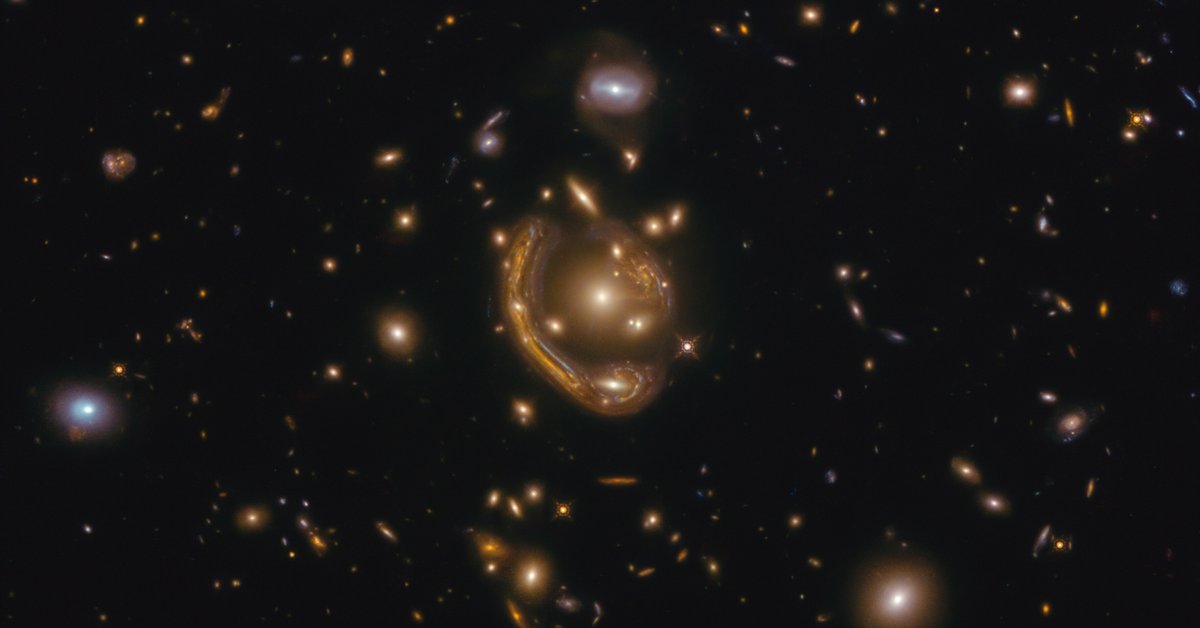:quality(85)/cloudfront-us-east-1.images.arcpublishing.com/infobae/Z3TQI7LGR5G3JJDVORLXLGSJFQ.jpg 420w,https://www.infobae.com/new-resizer/4OmMa1HfWHI5qoU0nzBP3-aLCCU=/768x432/filters:format(jpg):quality(85)/cloudfront-us-east-1.images.arcpublishing.com/infobae/Z3TQI7LGR5G3JJDVORLXLGSJFQ.jpg 768w,https://www.infobae.com/new-resizer/keDY92eEMg3t12MgHXDP5_-lVBY=/992x558/filters:format(jpg):quality(85)/cloudfront-us-east-1.images.arcpublishing.com/infobae/Z3TQI7LGR5G3JJDVORLXLGSJFQ.jpg 992w,https://www.infobae.com/new-resizer/Dvunn87VaoqyBlGrBLbbjkk3y1M=/1200x675/filters:format(jpg):quality(85)/cloudfront-us-east-1.images.arcpublishing.com/infobae/Z3TQI7LGR5G3JJDVORLXLGSJFQ.jpg 1200w,https://www.infobae.com/new-resizer/fHytCIMc1IZKqrUllDtOwkuvQHQ=/1440x810/filters:format(jpg):quality(85)/cloudfront-us-east-1.images.arcpublishing.com/infobae/Z3TQI7LGR5G3JJDVORLXLGSJFQ.jpg 1440w)
Thanks to the use of telescopes located in Chile The team of astronomers used a complex system To calculate the distance separating Albert Einstein’s “molten ring” from the Earth.
The curved galaxy in the image attached to this note and the circumference at its center are one of the most important mysteries in astronomy and one of the unparalleled rarities. This collection is known as the “Einstein Ring” or “Molten Ring” and is well known among experts with the GAL-CLUS-022058 identification., And Fornox (El Horno) are located in the Southern Hemisphere galaxy.
Through a report and publication in the scientific journal The Astrophysical Journal, International team of astronomers, led by Polytechnic University of Cartagena (UBCD) and Professor Anastasio Diaz in Spain They announced that they had measured the distance between Einstein’s “molten ring” and the Earth.
To achieve this, astronomers used a variety of instruments, such as a very large telescope. (VLT) of the European Southern Laboratory (ESO) located in the Taltal Commune north of Chile.
The distance between the galaxy and the Earth is estimated at 9.4 billion light years. In other words, it took 9.4 billion years for light from this ring to travel at the speed of light (i.e. 299,792.458 kilometers per second) until it reached the instruments used by astronomers.
The “Einstein Ring” was first raised by the German scientist in his famous theory of relativity. And the “ring” shape of this object can be explained by a process called “gravitational lensing”.
:quality(85)/cloudfront-us-east-1.images.arcpublishing.com/infobae/LPLCGOWZGZD4TH44LHOOZEGSC4.jpg 420w,https://www.infobae.com/new-resizer/ziXK1hszwzP3PtjtPJ4Vv47xYn8=/768x512/filters:format(jpg):quality(85)/cloudfront-us-east-1.images.arcpublishing.com/infobae/LPLCGOWZGZD4TH44LHOOZEGSC4.jpg 768w,https://www.infobae.com/new-resizer/ysTmqTZWiumBCRc9XYPp6YXhxLA=/992x661/filters:format(jpg):quality(85)/cloudfront-us-east-1.images.arcpublishing.com/infobae/LPLCGOWZGZD4TH44LHOOZEGSC4.jpg 992w,https://www.infobae.com/new-resizer/I5pJFyDy5xzJbSQJltjsMJX4_CE=/1200x800/filters:format(jpg):quality(85)/cloudfront-us-east-1.images.arcpublishing.com/infobae/LPLCGOWZGZD4TH44LHOOZEGSC4.jpg 1200w,https://www.infobae.com/new-resizer/dDGYW44qXOkzqKKCgBJtOV43lDM=/1440x960/filters:format(jpg):quality(85)/cloudfront-us-east-1.images.arcpublishing.com/infobae/LPLCGOWZGZD4TH44LHOOZEGSC4.jpg 1440w)
A “gravitational lens” is formed when the light of an object in space bends due to the gravitational pull of another massive object. Located between the emitter (Einstein ring) and the receiver (earth), it amplifies and distorts its shape.
In this way, the galaxy is quadrupled in the image of the “molten ring” and its true shape is rotated.
For those responsible for this discovery, reaching these results was very adventurous. Professor Anastasio Thias explained that this ring is one of the largest and most complete ever discovered. The nickname of the molten ring is due to its origin and its host galaxy (The Furnace).
The researcher also said that his investigative work took him many years To identify the physical properties of this galaxy, a unique gravitational lens model must be developed. Thanks to the work and pictures of the Hubble Telescope.
The origin of the rings
:quality(85)/cloudfront-us-east-1.images.arcpublishing.com/infobae/NLG7X3I7HJDDLGTZJPTEIL7WGU.jpg 420w,https://www.infobae.com/new-resizer/fRDDzRZa9Ifsq9R6jIuu0MV0mhw=/768x512/filters:format(jpg):quality(85)/cloudfront-us-east-1.images.arcpublishing.com/infobae/NLG7X3I7HJDDLGTZJPTEIL7WGU.jpg 768w,https://www.infobae.com/new-resizer/PmPxlaJK1DOggXcTx0ANwQZuwRc=/992x661/filters:format(jpg):quality(85)/cloudfront-us-east-1.images.arcpublishing.com/infobae/NLG7X3I7HJDDLGTZJPTEIL7WGU.jpg 992w,https://www.infobae.com/new-resizer/uge0f_F4ntWETwCjjTwP6qCzLgw=/1200x800/filters:format(jpg):quality(85)/cloudfront-us-east-1.images.arcpublishing.com/infobae/NLG7X3I7HJDDLGTZJPTEIL7WGU.jpg 1200w,https://www.infobae.com/new-resizer/YlH97nQkQeZk1wUCp0d5TlO-nY4=/1440x960/filters:format(jpg):quality(85)/cloudfront-us-east-1.images.arcpublishing.com/infobae/NLG7X3I7HJDDLGTZJPTEIL7WGU.jpg 1440w)
The origin of these phenomena was first given by the German physicist Albert Einstein, Who said in 1911 that light was affected by the gravitational pull of objects.
Einstein proposed this to confirm his views on general relativity. This suggests that the geometry of space-time is affected by the presence of heavy objects such as planets or galaxies.
This idea was confirmed in 1915 by another scientist, Arthur Eddington. Who confirmed this effect during a solar eclipse on the island of Frances, off the west coast of Africa.
At that moment, Arthur Eddington saw the stars near the eclipse appear out of place. The light was diverted due to the strong gravity of the sun. However, in 1979 the effect of technology was most severe. Since then Hundreds of Einstein rings have been found, but not far from what is in this picture.
The most distant galaxy
Nicholas Sulsenovir from the Max Planck Institute of Radio Astronomy in Germany Light from this ring has traveled about 9.4 billion light yearsWhat an unimaginable distance.
Sulsenovir also described the discovery of molecular gas that gives birth to new stars. This made it easier for astronomers to calculate the red change more accurately, Confirms that this is a very distant galaxy.
Among the scientists who contributed to this discovery were Anastasio Diaz-Sanchez (UBCD), Helmut Tannerpower (Institute de Astrophysica de Canarias), Nicholas Salsenoir (Instituteo Max Blanc de Radioastronomia, Germany), Susanna Iglesias-Groth (Institute de Astrophysica de Canarias) and Rafael Repolo (Instituto de Astrophobia).
Read:





:quality(85)/cloudfront-us-east-1.images.arcpublishing.com/infobae/KTKFKR763RBZ5BDQZJ36S5QUHM.jpg)